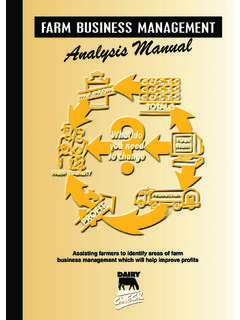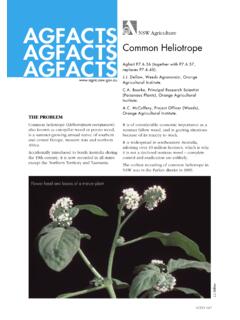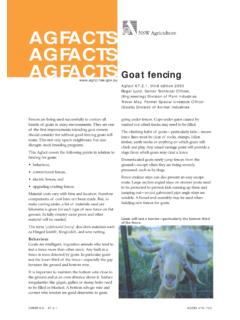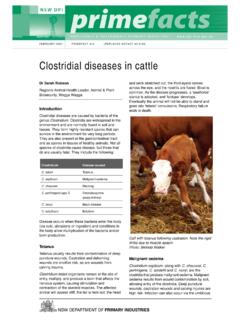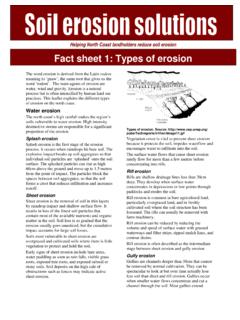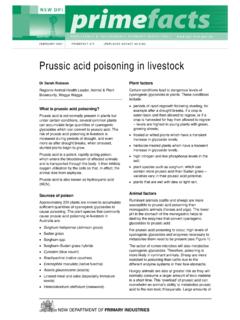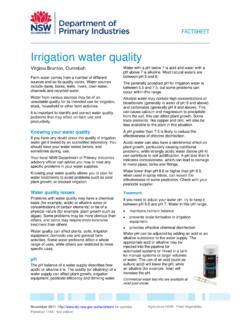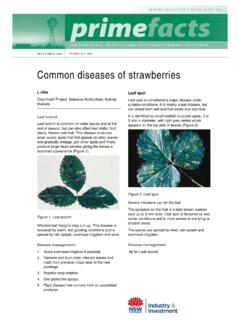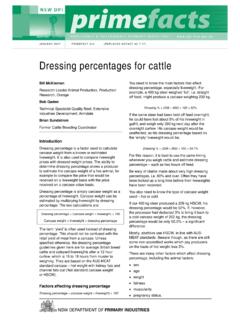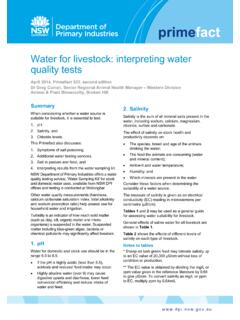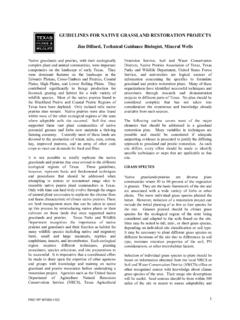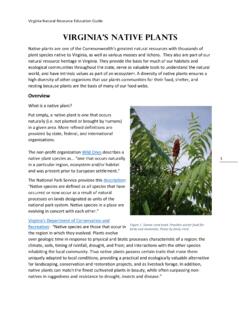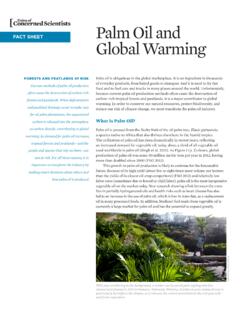Transcription of Lucerne for pasture and fodder - Department of Primary ...
1 AGFACTSAGFACTSAGFACTSA gdex 121/13 Order no. , third edition 2003W. McDonald, Technical Specialist (Pastures), , Senior Plant Pathologist, OrangeA. Bishop, Senior Research Scientist, GosfordM. Lattimore, District Agronomist, YancoP. Gardner, Agronomist (Seed Production),DubboR. Williams, Research Agronomist, TamworthL. Hyson, formerly Technical Assistant(Irrigation), TamworthLucerne forpasture andfodderOrder no. 121/132 ContentsPageSummary3 Introduction3 Uses4 Special features4 Production advantages and nutritive value5 Distribution and climatic limitations8 Soil requirements8 Varieties9 Establishment11 Companion crops13 Seeding rate14 Inoculation and lime pelleting15 Establishing Lucerne on acid soils16 Species to grow with lucerne16 Nutrition and fertiliser17 Grazing management21 Livestock health on lucerne24 Haymaking25 Making silage31 Renovation32 Terminating the Lucerne phase32 Irrigation33 Salinity37 Growing Lucerne for seed38 Weed control39 Pests and diseases40 References and further reading52 DISCLAIMERThe information contained in this publication is based on knowledge and understanding at the time ofwriting (December 2002).
2 However, because of advances in knowledge, users are reminded of the need toensure that information upon which they rely is up to date and to check currency of the information withthe appropriate officer of New South Wales Department of Agriculture or the user s independent that some of the information is provided by third parties, the State of NSW, the author and thepublisher take no responsibility for the accuracy, currency, reliability and correctness of any informationincluded in the document provided by third :Livestock health disordersPasture improvement may be associated with an increase in the incidence of certain livestock healthdisorders. Livestock and production losses from some disorders are possible. Management may need to bemodified to minimise risk. Consult your veterinarian or adviser when planning pasture vegetationThe native vegetation Conservation Act 1997 may regulate some pasture improvement practices whereexisting pasture contains native species. Inquire through your office of the Department of Land and WaterConservation for further READ THE LABELU sers of agricultural or veterinary chemical products must always read the label and any permit, beforeusing the product, and strictly comply with the directions on the label and the conditions of any are not absolved from compliance with the directions on the label or the conditions of the permit byreason of any statement made or not made in this flowerM LATTIMOREC over:Left: Hay cut in the Narrandera district(Photo: G Johnson); Right: Sheep on Lucerne atTamworth (Photo: NSW Agriculture)3 Figure 1.
3 Area of Lucerne in NSW (Source: AustralianBureau of Statistics 1922 97, estimates 1997 2000)SUMMARYL ucerne is a temperate perennial legume capableof producing high quality forage throughout theyear, but its main production period falls in thespring, summer and early is the third most widely grown pasturelegume in New South Wales (after subterraneanand white clover), and is considered the onlyreliable pasture legume for a large area of s wide range of uses, and high adaptability tothe climate and soils of NSW makes it an integralpart of the State s agriculture, especially in thewheat sheep area of Lucerne declined during the 1970 s,coinciding with an increase in cropping and thearrival of the destructive exotic Lucerne use of improved varieties has largelyovercome the aphid problem and has brought theadded benefit of resistance to a range of diseasespreviously restricting production, as well asbenefits in seasonal production and is a reliable plant for use as extensivepasture, intensive forage, and fodder Lucerne produces many benefits: Economic gains stem from both improvedlivestock production and increases in theyield and quality of subsequent cereal in application of nitrogenousfertilisers to subsequent crops and benefits inthe area of weed control are also significant.
4 Environmental benefits can be verysignificant. The ability of Lucerne to lowerhigh watertables, thereby reducing thepotential effects of salinity, is also assists in improving soilstructure and controlling erosion, especiallyas a part of a pasture mixture with grassspecies. Lucerne has also been usedeffectively as a fire-break, and because of itsdrought tolerance it enhances the stability ofpasture techniques have improvedsubstantially in recent years. Better machinery,cubing, recompression of bales and the use ofpreservatives now make Lucerne an even moreuseful and profitable species to main problems restricting Lucerne productionare soil type and soil pH, susceptibility to heavyand continuous grazing, loss of livestockproduction through bloat, diseases such ascommon crown rot, and the need for inexpensiveweed breeding programs are investigating bloatprevention, grazing tolerance, improved nutrientcontent, disease resistance and better adaptationto specific situations (for example, croppingrotations).
5 Herbicides are continually being testedin an effort to reduce the costs of establishmentand (Medicago sativa L.) is a high-producing,nutritious legume that is well adapted to a rangeof climates throughout the in the Middle East, it was introducedinto NSW before 1806, and in time spreadthroughout Australia. It grows in conditionsranging from tropical to temperate and willtolerate frosty area of pure Lucerne in NSW in 1996 (fromAustralian Bureau of Statistics data; 1996 was thelast year in which statistics were recorded forsome issues relating to Lucerne production) wasapproximately 280 000 ha (64 per cent of thetotal area sown in Australia). Of this area, anunusually high area (40 per cent) was cut forhay in that year (Figure 1); the majority wasproduced under irrigation, with the remainderunder rain-fed conditions. It is also sown inpasture mixtures (almost all rain-fed), with528 000 ha existing in 1996. A study by Hill andDonald (1996), suggested that NSW was also theState with the greatest potential for furtherincreases in area of hectares Total areaGreen feed areaHay area4 The area sown has varied markedly over the pasttwenty years.
6 During the 1970s the area declinedbecause of the trend to move away from pasturestowards cropping. This situation was exacerbatedby the arrival of the spotted alfalfa aphid in , sowing of pure Lucerne stands hasincreased steadily over recent years owing toconfidence in new aphid-resistant varieties andincreased interest in livestock production. Thearea of Lucerne increased further following thedrought years of the early 1990, as the benefits oflucerne as a drought-tolerant plant werehighlighted. Approximately 30 per cent of thepure Lucerne area and 30 per cent of the mixedlucerne area is resown annually. In 1996, this wasequivalent to approximately 83 000 ha of purelucerne and 153 000 ha in mixed the largest areas of Lucerne are grown inthe cropping belt, the heaviest concentrationsoccur along river may be grown as a pasture for year-round and special-purpose grazing, or for hay,silage, green fodder , pellets, cubes, seedproduction, sprouts or protein fractionation. The main use of Lucerne in NSW is as a pasturefor year-round grazing and in crop either alone or with other species, itprovides good feed in all seasons, provided thereis adequate soil grazed or used as fodder , Lucerne has ahigh nutritive value relative to other fodder atcomparable growth stages: it is high in protein,metabolisable energy, vitamins and minerals, allof which can increase animal production.
7 Whensown as a pasture phase, it can improve soilnitrogen levels and control crop weeds such aswild oats and some summer-growing can also be used as a special-purposepasture to finish prime lambs and beef cattle inlate spring and summer, when other pasturespecies are low in protein and may havedried traditional role of Lucerne in NSW is as a haycrop, with at least 406 000 t produced annually(1998 99). This represents 44 per cent of thelucerne hay produced in Australia. Production isusually on alluvial river flats and under irrigation,although opportunity hay is also made from dry-land grazing stands. Lucerne often gives higheryields than other pastures and can be made intofirst-class fodder (especially as hay and chaff).Hay yields from well managed irrigated stands arein the range of 10 22 t/ha, with best yields in theorder of 25 27 t/ha under exceptionalmanagement and growing of Lucerne products (hay, cubes and meal)from NSW has declined in recent years, withexport from the southern States increasing.
8 Anumber of factors appear to favour this trend,including freight advantages, more favourableharvesting conditions, domestic demand andcomparatively attractive domestic prices. The totalexport market for Lucerne products was 150 000tonnes in 1998 99, most destined for Japan. NSWexports in that year were less than 5 per cent ofthis , Lucerne is made into silage only if it isweedy or when the weather is unfavourable forhaymaking. Lucerne can also be harvested andfed fresh to stock as highly nutritious green chop particularly in feedlots and dairies but feedingto cattle must be restricted to avoid seed growers produce Lucerne seedmost efficiently, although some isopportunistically harvested, usually from grazingstands. A small proportion of the seed crop ismarketed as alfalfa sprouts for well as having a role as a legume ley incropping rotations, Lucerne also is used inconjunction with cotton production. Although itsuse is not widespread, a small area of a cottonfield is sown to a strip, border or block oflucerne and managed as it would be for irrigatedproduction.
9 The Lucerne strips effectively act asan attractant for some pests and beneficialinsects contributing to integrated pest controlprograms. Associated dryland areas are alsooccasionally sown to Lucerne for the samereason as well as to reduce the cost of also exists for protein fractionation,which provides products for specialised livestockfeeding and pharmaceutical industries, and forother industrial uses in the area of energy andbiodegradable plastics .SPECIAL FEATURESL ucerne has a number of features that make itextraordinarily versatile and is a reliable perennial, capable of producinggreen feed in most seasons subject to soilmoisture and temperature, and often when otherpastures are dormant. It can respond to rain inany season, so that the risk of extended feedshortages is greatly reduced and the opportunityfor out-of-season production suitable soils Lucerne develops a long taproot,enabling it to draw on deep soil moisture. Thus, itcan continue to grow long after surface moistureis depleted, shallow-rooted plants have wilted,and many annuals have died, giving it a strongcompetitive advantage over many taproot stores energy that is used toaccelerate the production of new Lucerne grows much faster afterautumn rain than germinating annual species,providing quicker autumn feed and allowingmore feed to build up before the onset of can offset the need for hand the plant is grazed or cut, fresh shootsgrow either from the remaining green stems orfrom buds in the crown (the top part of thetaproot).
10 Heavy grazing damages new buds, butin most varieties these are rapidly replaced. Thecapacity of Lucerne to produce buds and shootsfrom the crown at or below the soil surfacepromotes its survival, but continual heavygrazing will kill the nodulated, Lucerne can fix nitrogen that is,it can convert atmospheric nitrogen to a formavailable to the plant with the aid of rhizobiumbacteria. This nitrogen allows the plant tomaintain high protein levels and build up soilnitrogen. A good Lucerne stand can add in excessof 140 kg N/ha to the soil in one may live for up to 20 years, although thelife of an average stand is closer to five years. Asswards age, inappropriate cutting or grazingmanagement, weeds, disease and insects taketheir toll and the plant s survival correctly managed and grown, either aloneor with a perennial grass or annual legumes, Lucerne restricts the growth and spread of deep taproot can deplete soil watereffectively and lower water tables. This canreduce the effects of salination.
